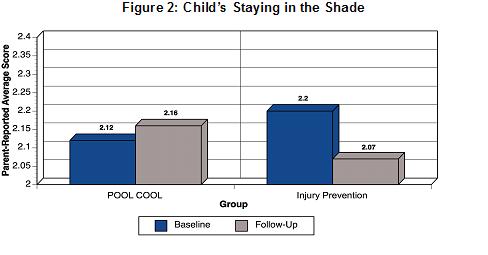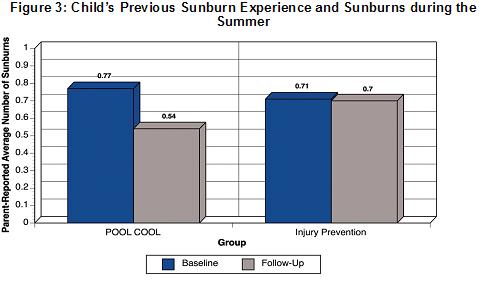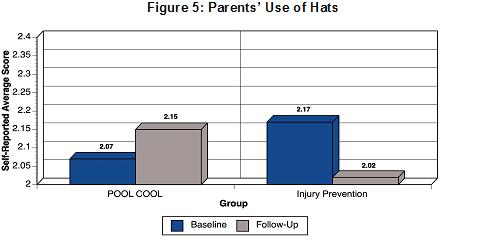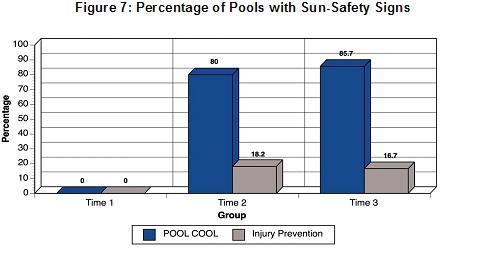Program Synopsis
Designed to increase awareness and promote sun protection behavior and practices, this intervention implemented at pools combines education for children and staff, interactive activities for children and parents, and pool-wide environmental changes. The study showed improvements in various sun protection behaviors among children and parents and improvements in pool policies and environment.
Program Highlights
Program Materials
Preview and order the materials from the developer
Insights from the Cancer Control Field
See how implementers have used this program in the field
Program Scores
The Need
Skin cancer is the most commonly diagnosed form of cancer in the United States, accounting for an estimated 1.3 million new cases of cancer each year. The incidence rate of melanoma, the most deadly form of skin cancer, has more than doubled since the early 1970s. There will be an estimated 13,590 deaths from melanoma and other non-epithelial skin cancer in 2007. It is widely known that protection from the sun's rays could prevent about 90 percent of all skin cancer cases. Youth are most at risk for overexposure to ultraviolet radiation (UV rays) because they spend the most time outdoors in the sun. It is estimated that 80 percent of lifetime UV exposure is received during childhood. Those who receive the most overexposure to the sun (tanning and burning) tend to have the highest rates of skin cancer later in life.
Protection includes covering up (e.g., hats, long sleeves, pants), seeking shade, using sunscreen properly (high sun protection factor [SPF] with frequent reapplication), and avoiding staying outside too long during peak sun hours (10:00 a.m.- 4:00 p.m.). Outdoor recreation settings, particularly aquatics settings such as swimming pools, are especially promising for skin cancer prevention activities for several reasons:
- Children and adults are minimally clothed.
- Swimming lessons offer a structure for teaching sun safety skills.
- Families and communities often gather at swimming pools in the summer.
- Lifeguards and aquatics instructors can serve as role models.
- Environmental changes and supportive policies can promote solar protection for all pool users.
The Program
The POOL COOL program is a multi-component sun-safety education program especially designed for use at swimming pools. Its main objective is to increase awareness, motivation, and sun protection practices among children aged 5-10 who take swimming lessons, parents of the children, pool staff, and other pool users.
The POOL COOL Program teaches children about the dangers of overexposure to the sun and encourages them to develop healthy habits for a lifetime. Lessons are taught in conjunction with regular swimming lessons, with the curriculum combining education, interactive activities at the pool, and pool-wide environmental changes. The main components are:
- A lifeguard/aquatics instructor training module.
- The Leader's Guide for pool staff.
- An eight-lesson curriculum on sun safety to be presented by aquatics instructors in their classes.
- Interactive activities on sun protection to be conducted with children aged 5-10 and their parents. Includes demonstrations, games, and puzzles to supplement and support the lessons.
- Provision of shaded areas, signage, and sunscreen dispensers at the pool.
- Promotion of sun-safe environments.
Community Preventive Services Task Force Finding
 This program uses an intervention approach recommended by the Community Preventive Services Task Force: interventions in outdoor recreational and tourism settings (Sun Safety and Indoor Tanning). This program also uses the following intervention approach for which the Community Preventive Services Task Force finds insufficient evidence: interventions targeting children's parents and caregivers (Sun Safety and Indoor Tanning). Insufficient evidence means the available studies do not provide sufficient evidence to determine if the intervention is or is not effective. This does not mean that the intervention does not work. It means that additional research is needed to determine whether the intervention is effective.
This program uses an intervention approach recommended by the Community Preventive Services Task Force: interventions in outdoor recreational and tourism settings (Sun Safety and Indoor Tanning). This program also uses the following intervention approach for which the Community Preventive Services Task Force finds insufficient evidence: interventions targeting children's parents and caregivers (Sun Safety and Indoor Tanning). Insufficient evidence means the available studies do not provide sufficient evidence to determine if the intervention is or is not effective. This does not mean that the intervention does not work. It means that additional research is needed to determine whether the intervention is effective.Time Required
The POOL COOL Program consists of a total of eight lessons, each taking no more than 5 minutes at the start of swim class. The program also contains five additional sun-safe poolside activities that can be conducted with kids when there is more free time available.
In addition, a one hour orientation and training was provided to pool staff.
The amount of time required to plan for and implement sun safety policies and environmental changes varies depending on how many of these components a pool implements.
Intended Audience
The primary audiences for the POOL COOL intervention include children aged 5-10 taking swimming lessons at participating pools, their parents (or caretakers), and the aquatic staff.
Suitable Settings
The POOL COOL program is especially designed for use at outdoor swimming pools.
Required Resources
The basic POOL COOL toolkit includes-
- The Leader's Guide (lessons, activities, and information about skin cancer) for pool staff
- Laminated lesson sheets (for poolside use): a series of eight sun safety lessons
- Decision-Maker's Guide for Sun-Safe Swimming Pools (to help managers implement a sun-safe environment and policies at their pools)
- Resource Guide (contact list of vendors that provide sunscreen, shade structures, etc.)
- CD-ROM (copies of the above-listed items, signs, posters, logos, and other POOL COOL artwork and information)
The deluxe POOL COOL toolkit includes-
- Basic POOL COOL toolkit
- Mini-Big-Book: POOL COOL Rules for Sun Safety (visual aid for teaching lessons, graphics on CD
- UV activity index cards (to accompany activities in Leader's Guide, also on CD)
- UV-meter cards (to accompany activities in Leader's Guide)
- UV-sensitive patches and wristbands (to accompany activities in Leader's Guide)
Additional items include-
- Shade structures (e.g., umbrellas, awnings, canopies--purchased independently)
- Sunscreen (purchased independently)
- Sun Jeopardy game board (to accompany activities in Leader's Guide, also on CD)
- Sunscreen Tips sign (for display on pool premises, on CD)
- Play it Safe poster (to accompany activities in Leader's Guide, also on CD)
- Aluminum sun-safety signs (for display on pool premises, on CD)
- The POOL COOL Guide to Sustainability - to help make the sun-safety program a permanent part of programming
- Miscellaneous incentive items such as lanyards for lifeguards, message pens, Pool Cool T-Shirts, hats, sunscreen samples, disposable cameras, etc.
- DVD providing the story of a 20-year-old woman who died of melanoma and presenting sun-safety tips
For swimming pools that are not already participating in the POOL COOL research study, materials can be downloaded for free from the Pool Cool website (https://www.med.upenn.edu/poolcool/) or purchased from the National Recreation and Park Association (www.nrpa.org).
About the Study
The POOL COOL Program was evaluated using a cluster randomized controlled design to assess the impact of the program on sun-protection habits and swimming pool environments. The POOL COOL Program was compared with a program similar in format, with injury prevention as the topic. Both educational and environmental strategies were tested in 28 swimming pools in Hawaii and Massachusetts. A total of 1,010 parents/caregivers completed baseline surveys regarding themselves and their children, aged 5-10 years (mean age 6.6 years), who were enrolled in swimming lessons. Children were 47.1% female and 52.9% male, and 57.2% of parents/caregivers identified themselves as Caucasian.
Parents completed surveys concerning themselves and their children about skin cancer risk factors, knowledge about skin cancer and sun-protection guidelines, attitudes, and policies for sun protection at the swimming pool. Surveys were completed at the beginning of the summer and approximately 8 weeks later, near the end of the swimming lessons season. POOL COOL research staff conducted observations at the beginning, middle, and end of the summer to ascertain environmental changes, including the sun-safety environment (availability of sunscreen, shaded areas, and sun-safety signage) and lifeguard sun-safety practices (wearing hat, shirt). Findings for the main targeted outcomes are presented below.
Key Findings
Effects of the POOL COOL Intervention on Child Sun-Protection Habits and Sunburn
Parents of children who received the POOL COOL intervention reported significantly higher use of sunscreen (baseline M=3.09, follow-up M=3.15), shade (baseline M=2.12, follow-up M=2.16) and higher composite sun protection habits* scores (baseline M=2.29, follow-up M=2.30) for their children at follow-up than parents of children who received the injury prevention intervention.
*The composite sun protection habit score was created from five protective behaviors (using sunscreen, wearing a hat, wearing a shirt, seeking shade, and wearing sunglasses) on a 4-point scale ranging from 1 (rarely/never) to 4 (always), adding the responses for each behavior and dividing by the number of items answered to obtain a summary score, ranging from 1 to 4.


Parents of children at moderate or high risk for skin cancer who received the POOL COOL intervention reported a 23% reduction in children sunburns compared with the preceding summer, while parents of children at moderate or high risk who received the injury prevention intervention reported only a 1% reduction (p=.04).

Effects of the POOL COOL Intervention on Parents' Sun-Protection Habits, and Pool Sun-Protection Policies
Parents of children who received the POOL COOL intervention self-reported significantly more use of sunscreen (baseline M=2.52, follow-up M=2.56), hat use (baseline M=2.07, follow-up M=2.15), and higher composite sun protection habits scores (baseline M=2.45, follow-up M=2.52) at follow-up than parents of children who received the injury prevention intervention.


At follow-up, the POOL COOL group parent surveys showed substantially greater increases in sun-protection policies at their pools compared with the injury prevention group: 2.59 compared with 1.67, or 55.1% higher on a scale of 0 to 4 (p<.001).

Knowledge scores, relatively high at baseline, remained virtually unchanged in both groups at follow-up.
Observational Findings of Changes in Sun-Safety Environments and Lifeguard Sun Protection
Pools in the POOL COOL trial had greater improvements in posting of sun-safety signs (p<.01), availability of sunscreen (p<.05), and lifeguard shirt use (p<.01).


Dose-Response Effect of the POOL COOL Intervention
There was a significant dose-response effect on Sun Protection Habits for children receiving two or more lessons or activities compared with those whose parents reported that they received zero or one (p<.05).

Publications
Glanz K, Isnec MR, Geller A, Spangler K. (2002). Process evaluation of implementation and dissemination of a sun safety program at swimming pools. In Steckler A, Linnan L (Eds.), Process Evaluation in Public Health Interventions, 58-82. San Francisco, CA: Jossey-Bass Inc, Publishers.


